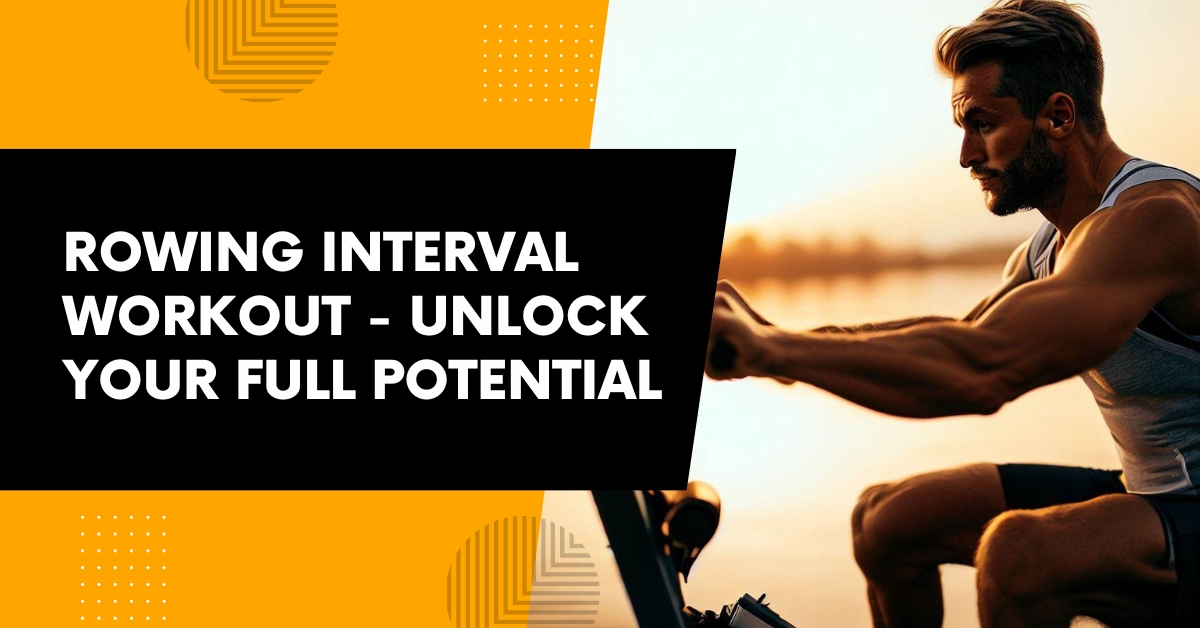Elevate your fitness routine with rowing interval workouts. Experience the benefits of high-intensity intervals, maximize calorie burn, and engage multiple muscle groups. Achieve your fitness goals efficiently with rowing interval workouts.
Introduction
As a highly effective method of achieving a full-body workout while improving cardiovascular health, rowing interval workouts have gained popularity in recent years. As part of this comprehensive guide, you will learn about rowing interval workouts, how they work, techniques, workout plans, progress tracking, safety tips, and much more. This article will provide you with valuable insights into how to enhance your rowing interval workout routine, whether you are a beginner or an experienced rower.
Benefits of Rowing Interval Workouts

Cardiovascular Health
Interval rowing workouts provide exceptional cardiovascular benefits, making them an excellent choice for improving heart health. The dynamic nature of rowing engages large muscle groups and elevates the heart rate, improving endurance and stamina.
Full-Body Workout
A rowing interval workout engages multiple muscle groups simultaneously, unlike many other forms of exercise that focus on only one or two muscles. This full-body exercise helps build strength and muscle tone in the arms, legs, back, and core.
Weight Loss
Rowing interval workouts have proven to be highly effective for weight loss because they burn a significant amount of calories. The combination of cardio exercise and resistance training promotes fat loss while preserving lean muscle mass.
Increased Muscle Strength and Endurance
By regularly rowing interval workouts, you will increase your muscle strength and endurance. The resistance provided by the rowing machine helps build and tone muscles, resulting in increased strength and power.
Low-Impact Exercise
A rowing machine can be a great way to get a great workout while not putting excessive strain on your body. The machine provides a challenging workout while not putting your body under as much stress or injury risk as other exercise machines.
Mental Well-being
The rhythmic motion of rowing and the release of endorphins contribute to the reduction of stress, improved mood, and improved mental clarity associated with rowing interval workouts.
How to Get Started with Rowing Interval Workouts
It is essential to have the appropriate equipment and to master proper technique and form prior to beginning your rowing interval workout journey.

Equipment and Gear
Rowing machines or ergometers are necessary for performing rowing interval workouts. These machines simulate the action of rowing on water and provide adjustable resistance. Additionally, ensure that you wear comfortable workout attire, supportive shoes, and hydrate with a water bottle.
Proper Technique and Form
If you wish to maximize the effectiveness of your rowing interval workouts while minimizing the risk of injury, it is imperative that you master proper technique and form. To ensure smooth and efficient strokes, maintain a tall posture, engage your core muscles, and follow the correct sequence of movements.
Warm-up and Cool-down Routines
To prepare your body for exercise, it is important to warm up your muscles and warm up your body before beginning the main workout. To increase blood flow and loosen up, perform dynamic stretches, such as arm circles and leg swings. To aid in muscle recovery, engage in static stretching and gentle movements after completing the workout.
Types of Rowing Interval Workouts
It is possible to customize rowing interval workouts to meet the fitness goals and preferences of different individuals. Here are some examples:

Time-Based Intervals
The purpose of time-based intervals is to alternate between different rowing intensities for specific periods of time. An interval structure can be customized based on your fitness level and goals. For example, you might row at a high intensity for one minute and then row at a lower intensity for 30 seconds.
Distance-Based Intervals
When you perform distance-based interval training, you choose a specific distance goal and alternate between higher and lower intensities until you reach it. This type of workout motivates you to achieve specific goals.
Pyramids and Ladders
In pyramids and ladders, rowing intervals are gradually increased or decreased in intensity or duration. For instance, you might start with a short period of high intensity, followed by a longer period of recovery. After that, increase the duration of the high-intensity intervals gradually before decreasing them again.
Tabata Intervals
HIIT (high-intensity interval training) Tabata intervals follow a specific structure and consist of 20 seconds of all-out effort followed by 10 seconds of rest, repeating for a total of eight intervals. Despite the intensity, this type of workout is extremely effective in building endurance and burning calories.
Interval Training Programs
Pre-designed interval training programs are available that offer structured workouts for rowing. They often combine different interval types and provide a progressive training plan to help you achieve specific fitness objectives.
Sample Rowing Interval Workouts
Here are three sample rowing interval workouts designed for different fitness levels to give you a head start:

Beginner Workout
- Warm-up: Row at an easy pace for 5 minutes.
- Intervals: Alternate between 2 minutes of rowing at a moderate intensity and 1 minute of active recovery (rowing at a slow pace) for a total of 20 minutes.
- Cool-down: Row at an easy pace for 5 minutes.
Intermediate Workout
- Warm-up: Row at an easy pace for 5 minutes.
- Intervals: Perform 5 sets of the following:
- 4 minutes of rowing at a challenging intensity
- 2 minutes of active recovery
- Cool-down: Row at an easy pace for 5 minutes.
Advanced Workout
- Warm-up: Row at an easy pace for 5 minutes.
- Intervals: Perform the following ladder workout:
- 1 minute of rowing at a moderate intensity
- 1 minute of active recovery
- 2 minutes of rowing at a challenging intensity
- 1 minute of active recovery
- 3 minutes of rowing at a challenging intensity
- 1 minute of active recovery
- 4 minutes of rowing at a challenging intensity
- 1 minute of active recovery
- 3 minutes of rowing at a challenging intensity
- 1 minute of active recovery
- 2 minutes of rowing at a challenging intensity
- 1 minute of active recovery
- 1 minute of rowing at a moderate intensity
- Cool-down: Row at an easy pace for 5 minutes.
Monitoring Progress and Tracking Results
During your rowing interval workouts, it is important to keep track of your progress in order to stay motivated and monitor improvements over time. Here are some methods you can use to track your progress:
Tracking Distance and Time
You can record the distance covered, time taken, and stroke rate for each rowing session. This data can assist you in setting goals, tracking improvements, and challenging yourself to beat previous records.
Heart Rate Monitoring
When you are rowing interval workouts, keeping a close eye on your heart rate can provide valuable insight into the intensity of the exercise. You can use a heart rate monitor or the integrated heart rate tracking feature on some rowing machines to ensure you are maintaining your target heart rate zone during your workouts.
Using Fitness Apps and Wearables
A number of fitness apps and wearable devices are available that can help you track and analyze your rowing interval workouts. These apps may provide detailed workout summaries and progress graphs, as well as additional features such as training plans and virtual challenges.
Safety Tips and Precautions
It is generally safe to perform rowing interval workouts, but it is important to follow some safety precautions and tips in order to avoid injury and to ensure a successful workout:
Proper Warm-up and Cool-down
You should always warm up your body before engaging in intense rowing intervals. Perform dynamic stretches and gradually increase intensity to prepare your muscles for the workout, and cool down with gentle movements and static stretches to aid in recovery afterward.
Listen to Your Body
Make sure you pay attention to how your body feels during a workout. If you experience any discomfort, pain, or unusual symptoms, stop exercising and seek assistance from a healthcare professional. Push yourself, but don’t ignore warning signs from your body.
Gradual Progression
Allow your body to adjust and progress at a pace that is appropriate for your fitness level as you gradually increase the intensity, duration, or frequency of your rowing interval workouts.
Hydration and Nutrition
Ensure that you remain hydrated before, during, and after your workouts. Make sure to drink water regularly to replenish fluids lost through sweat. In addition, ensure that you eat nutrient-rich foods to provide your body with the energy and nutrients necessary for optimal performance.
FAQ’s
1. How long should rowing intervals be?
Optimize your workout by incorporating both high-intensity and low-to-moderate-intensity intervals lasting 20 to 30 seconds each, followed by equal recovery periods. The exercise routine should be dedicated to 10 minutes every day. It is recommended that you maintain a stroke rate of 30 to 38 during the high-intensity intervals. Maintain a steady pace during the low-intensity intervals by aiming for a stroke rate of 20 to 24 per minute.
2. Is rowing interval training?
The most effective way to maximize your workout efficiency is to use interval training in rowing workouts, especially when your time is limited. As compared to non-interval workouts performed within a similar time period, high-intensity interval workouts have been demonstrated to burn 25-30% more calories.
3. Are rowing intervals good?
High-intensity interval training (HIIT) is compatible with rowing interval workouts, one of the notable advantages of engaging in rowing interval workouts. Research indicates that rowing engages approximately 86 percent of the muscles in your body, making the rowing stroke a comprehensive full-body exercise.
4. Is 20 minutes of rowing a day enough?
Maintaining consistency is imperative when it comes to achieving weight loss. It is recommended that you row for at least 15 to 20 minutes each day, ideally three to five times per week. The importance of adequate rest days cannot be overstated, particularly if you are just beginning your fitness journey. It is vital that you strike a balance between exercise and rest in order to achieve the best results.
5. Is rowing 500 meters in 2 minutes good?
There is no universally accepted definition of a good 500m rowing time. The fastest time recorded during the 500m event was 01:10.5. On average, a good 500m time is around 01:40.5 for all ages and genders.
Conclusion
Interval workouts provide an effective and time-efficient method of exercising. You can maximize your calorie burn by incorporating high-intensity intervals into your rowing routine, while simultaneously engaging a significant portion of your muscle group. In order to achieve optimal results and progress on your fitness journey, consistency, balance, and adequate rest days are essential.

